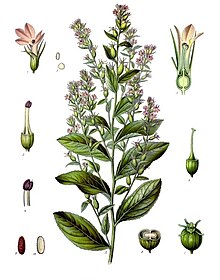Lobelia inflata
| Indian tobacco | |
|---|---|

| |
| Lobelia inflata[1] | |
| Scientific classification | |
| Kingdom: | |
| (unranked): | |
| (unranked): | |
| (unranked): | |
| Order: | |
| Family: | |
| Subfamily: | |
| Genus: | |
| Species: | L. inflata
|
| Binomial name | |
| Lobelia inflata | |
Lobelia inflata (Indian tobacco, puke weed) is a species of Lobelia native to eastern North America, from southeastern Canada (Nova Scotia to southeast Ontario) south through the eastern United States to Alabama and west to Kansas.[2]
Growth

Lobelia inflata is an annual or biennial herbaceous plant growing to 15–100 cm (5.9–39.4 in) tall, with stems covered in tiny hairs. Its leaves are usually about 8 cm (3.1 in) long, and are ovate and toothed. It has violet flowers that are tinted yellow on the inside, and usually appear in mid-summer and continue to bloom into fall.[3]
Propagation
Propagation is usually accomplished by cuttings or seed. Seeds are sown in containers in mid spring or mid fall. The seeds take about 2 weeks to germinate.
Traditional uses
Lobelia inflata has a long use as a medicinal plant, as an entheogenic, emetic, and a dermatological and respiratory aid.[4] Native Americans used it to treat respiratory and muscle disorders, as a purgative, and as a ceremonial medicine.[4] The plant was used as a traditional medicinal plant by the Cherokee, Iroquois, Penobscot, and other indigenous peoples. The foliage was burned by the Cherokee as a natural insecticide, to smoke out gnats.[4] It was widely used in the pre-Columbian New England region, long before the time of Samuel Thomson, who was erroneously credited as discovering it.
It is still used medicinally in the present day,[5] however there are adverse effects that limit its use.[6] Side effects can include sweating, nausea, vomiting, diarrhea, tremors, rapid heartbeat, mental confusion, convulsions, hypothermia, coma, and death.[7]
Chemical constituents
L. inflata contains lobeline.
References
- ^ Franz Eugen Köhler, 1897, Köhler's Medizinal-Pflanzen
- ^ "Lobelia inflata L." Germplasm Resources Information Network. United States Department of Agriculture. 1994-08-23. Retrieved 2009-04-09.
- ^ Caldecott, T. Western Materia Medica: Lobelia inflata (pdf file)
- ^ a b c University of Michigan at Dearborn: Native American Ethnobotany of Lobelia inflata
- ^ "Lobelia". EBSCO Complementary and Alternative Medicine (CAM) Review Board. January 2006. Retrieved 2007-09-12.
- ^ "Risky pills: Supplements to avoid". Consumer reports. 73 (1): 46–7. 2008. PMID 18488285.
- ^ "Lobelia". University of Maryland Medical Center.
External links
- Lobelia
- Flora of Eastern Canada
- Flora of the Northeastern United States
- Flora of the North-Central United States
- Flora of the Southeastern United States
- Flora of the Appalachian Mountains
- Flora of the Great Lakes region (North America)
- Entheogens
- Plants used in traditional Native American medicine
- Plants described in 1753
